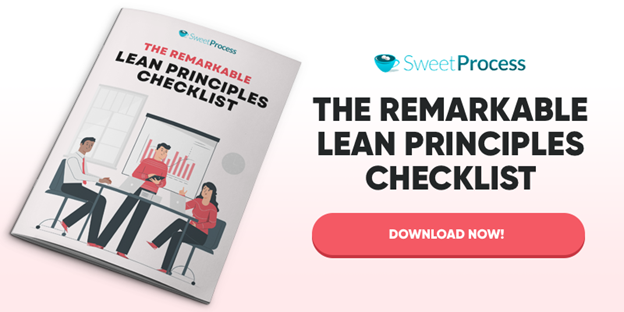Last Updated on May 1, 2025 by Owen McGab Enaohwo

Are you regularly onboarding new employees and adding capacity but still can’t explain to your customers with certainty when their orders will ship?
Do you need hiking boots to climb the mountain of excess inventory stocked in your storeroom, in fear of “What if something happens”?
These underlying issues (and more) prevent your business from achieving its efficiency, its peak performance, and the next level of success.
When managerial leaders don’t know what’s required to improve output, or what to do to avoid waste, costly issues arise in the company.
If you’re looking to add value to your work, company, and day-to-day routine, look to lean. Lean is a simple way of thinking that helps you create value with zero waste and fewer resources.
It’s an approach we use to transform a company’s culture and encourage continuous process improvements to achieve value with less waste.
Some of the world’s biggest brands were built using lean, a concept so powerful that it creates value while eliminating waste in any organization.
Here’s everything you need to know about lean principles.
Chapter 1: What Are the 5 Principles of Lean?
Chapter 2: Seven Wastes of Lean Methodology
Chapter 3: Benefits of Lean Principles
Chapter 4: Drawbacks of Lean Principles
Chapter 5: How to Implement Lean Principles
Chapter 6: Differences Between Agile and Lean Principles
Chapter 7: Lean Tools and Their Applications
Chapter 8: Industries Benefiting From Lean Methodology
Chapter 9: Using SweetProcess to Implement Lean Principles
Chapter 1: What Are the 5 Principles of Lean?
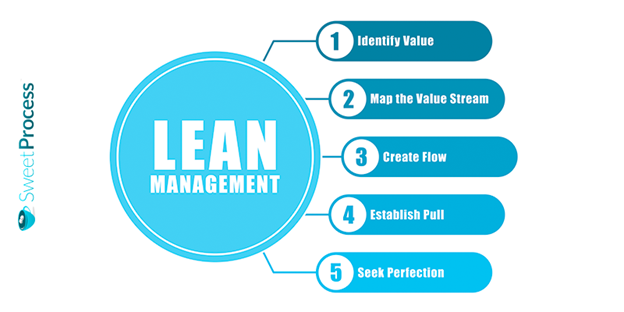
There’s no better and more effective model for managing teams than lean. Its value cuts across industries such as construction, manufacturing, and software development.
What tips the scales in the model’s favor? It’s simple to implement and so easy to understand. When applied properly, lean can positively impact an organization.
In the 1990 book The Machine that Changed the World authors James Womack, Daniel Roos, and Daniel Jones widely described the principles of lean methodology.
After many interactions and considerable reflection, they refined the principles, summarizing them into five in the subsequent 1996 volume, Lean Thinking.
Here are the five principles of lean and how to implement them.
- Identify value
- Map value stream
- Create flow
- Establish pull
- Continuous improvement
Define Value
Lean principles begin from a place of value. Only the customer can define value, and they express this value when buying a specific product (or service) from you that meets their needs at a specific price and time.
In short, anything that your customer is paying you for is value.
But what of team members working in a company? Do they create value for the company’s customers? No. They instead improve a product’s value that the company delivers to the end-user. In this context, the company is the customer.
For example, the value of a company’s quality assurance team is measured by the number of software bugs they identify. Their combined effort guarantees the company will deliver increased value to the customer or end-user.
The work of lean methodology is to reduce Muda (Japanese term for “waste”). Waste activities are categorized into:
- Necessary waste (value-adding waste)
- Pure waste (non-value adding waste)
Pure waste activities bring more harm than good to the lean methodology, while necessary waste activities are simply necessary for supporting value.
From the example, quality assurance is a “necessary waste”—it hardly provides customer’s value, but it assures the value of the development process is felt through mapping the value stream to clearly visualize the processes.
Map the Value Stream
Identifying and creating value is just half the journey. You need to also visualize the stream of value leading to the customer.
In the lean model, you can map the value stream by employing the use of kanban boards. This project management tool displays the entire process steps in a basic kanban board, giving you a visual insight into your team’s flow of work.
Kanban boards were first used as part of the Toyota Production System (now hailed globally for laying the foundation for principles of lean methodology).
A basic kanban board comprises three primary columns:
- Requested
- In Progress
- Done
To visualize your flow of work better, map the value stream even more precisely. Add the steps composing each stage as follows:
The Requested column includes two more additional steps: “Ready to Start” and “Order Received.”
Usually, the “In Progress” column defines the limit of the work. For example, in the context of software development, you can split the In Progress column into multiple columns representing crucial steps such as tech design, coding, ready to code review, code review, and ready to deploy.
The “Done” column is a collection of all completed items or all the work done. For example, once a team member completes their coding task, they move the item into the “Done” column where it awaits testing.
First time to map a value stream? Just make sure to focus on value-adding steps to create a lean-focused process. Also, ensure to continuously improve the process as you go.
Create Flow
Once you accurately define value and map the value stream, the next step is to make value-creating steps flow. In lean methodology, flow is an integral concept.
To make value flow, ensure the delivery process flows smoothly from the beginning (when you receive an order) until the end (when you deliver the product or service to the customer).
But odds are, you’ll experience bottlenecks (a stage where tasks will get stuck) along the way that might hinder your flow of steps in the process. If that happens, identify where the bottlenecks are to understand why they’re occurring.
Bottlenecks in a workflow are sometimes triggered when you need to wait too long on external stakeholders or have a lack of capacity at a specific stage in the process.
It’s important to eliminate bottlenecks in your process to ensure a smooth flow of work and a lean methodology of doing things.
Sometimes eliminating bottlenecks can be problematic but can be done with good guidance in the right direction.
For example, to keep your existing bottlenecks from being clogged, organize your work in small or large batches, ensure your quality of work is top-notch and arrives on time, and finally, never leave work idling.
As you progressively eliminate bottlenecks, point out to your team how multitasking is harmful to their productivity, then suggest different work-in-progress (WIP) limits that improve efficiency and flow of work.
Establish Pull
Once your value-created steps flow smoothly, create a pull system.
This system demands you create products or services only when necessary or when needed—especially when resources are scarce and teams lack capacity.
The goal is to avoid creating excesses or overproducing to reduce excess inventory. In simple words, only create the value needed by your customers.
To understand the pull system clearly, compare it with the push system.
A pull system saves tasks in a queue where a designer or an individual assigned to do the task can take a high-priority item from the queue and work on it. Other individuals can do the same: assign themselves tasks and start processing them.
A push system is different, as tasks are directly assigned to a designer. For example, a team leader collects tasks and then assigns them to teams. In other words, work is pushed to specific individuals to work on it.
As a lean-focused organization, delivering value to customers is imperative. A good way to do that is to focus on two key metrics:
- Throughput (tasks you complete at a specific time)
- Cycle time (time that teams take working toward completing a task)
If you wish to implement principles of lean methodology in your organization, focus on shorter cycle times to increase your team’s throughput. For example, eliminating bottlenecks and other inconsistencies from the process is a good way to reduce cycle times as is working on smaller sections of the project.
Pursue Perfection
When you let customers “pull” value from your products, you immediately begin pursuing perfection by constantly improving every process completed by your team.
You achieve this goal when you focus on value-generating activities that eliminate waste and promise value to your customers.
To continuously improve processes (and inspire your team), use the plan-do-check-act (PDCA) methodology. The best way to push your team members to seek continuous improvement is to focus on how you lead them to achieve that goal.
If you’re stuck on traditional methods of doing things, such as controlling all activities and micromanaging every task, embrace a cultural change.
When everyone on your team works on their tasks as needed, continuous improvement efforts will take center stage in the organization.
Apart from implementing lean, as a manager you’re responsible for helping teams understand why each principle holds importance to the organization.
In Lean Thinking, Jim Womack shares more insights about deploying lean principles, suggesting that you should first think about your business purpose, process, and then people.
Purpose: To discover your purpose, identify what your customers want. Is it better quality? Flexible designs? Higher margins? Find ways to satisfy your customers and decide what to improve to achieve business success.
Process: Next, evaluate your process (a stream of value, in this context) that seeks to provide value to your customer. Make all the steps relevant to your customer and work on the success of your business.
People: Lastly, think about your people. Is there someone responsible in every crucial process in your business to evaluate the value stream in regards to purpose?
Chapter 2: Seven Wastes of Lean Methodology

A customer decides how much they value your product with their money. So creating the right product or service is imperative for success. To foster productivity, reducing waste in your processes is inevitable.
In the context of production, here are seven wastes of lean methodology:
- Transportation
- Inventory
- Motion
- Waiting
- Overprocessing
- Overproduction
- Defects
Transportation
The unnecessary movement of a product or material from point A to B is a waste of resources. It adds no value to the product itself.
In lean production, moving products (that don’t need processing) unnecessarily is costly because you risk damaging, delaying, or losing the product in the process. The longer you transport the product, the sooner its value depreciates.
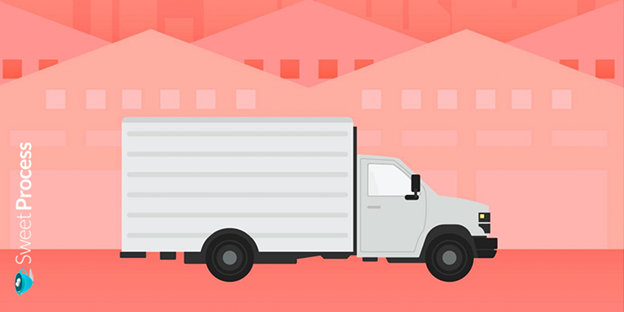
What causes transportation waste?
- Large batch sizes
- Complicated production processes
- Poorly designed production lines
- Having multiple storage locations
The solution: Minimize moving products while they are in their production stage and eliminate steps between two processes because the more steps you have, the less efficient your process will be.
Unnecessary Inventory
Inventory is money sitting idle waiting for you to spend it—it adds no value to your organization. Before you create a market-changing product, first create a minimal viable product (MVP) or a product with enough features to attract early-adopter customers. In the software industry, an MVP helps product teams to receive quick feedback from users to help improve the product.
Never create a product for sale until you know where to sell it. Is there a market for the product? Have real and solid orders in hand, then create the product, not the other way around.
Stocking up more inventory—and adding extra purchases early into the process—only serves to create more waste in terms of storage costs and extra time required to sort through the inventory, because you’ll soon need to pivot to match the real market.
What causes excessive inventory?
- Inventory defects
- Overspending on inputs
- Overproduction of unsold goods
The solution: Avoid stocking up more inventory. Just buy what you need and in enough quantities that you can use them right away.
Motion
All movement that is not streamlined is considered a “motion waste.” While this waste bears similarities to transportation waste, it generally refers to the unnecessary motion of operators and equipment. Think people and driven machines.
When people or driven machines have to walk or move excessively to perform a particular process, then you’re burdened with waste.
Excessive waste (even at micro levels in an organization) triggers stress. To increase productivity, you want to save as much energy and resources as possible.
Examples of motion waste include:
- Lifting bulk materials instead of using them in place
- Searching for lost items
- Walking about all the time to manually deliver paperwork
- Non-ergonomic office layouts
The solution: Because motion waste interrupts and delays the flow of work, implement lean tools to help optimize all motion in the production line and work environment.
Waiting

Waiting for the next production step to happen (for you to act) is a waste of time. In the context of production, idle time occurs when two similar processes are not synchronized to work or perform similarly.
A case in point is when a team member is sitting idly waiting to get a response from another department about the next course of action.
What causes the waste of waiting?
- Bottlenecks (a blockage in the workflow) to team productivity
- Idle equipment or unprecedented downtime
- Poor planning of processes
The solution: Synchronize all business processes in one place to minimize waiting time. Also, standardize work processes to improve the time of production.
Overprocessing
In production, overprocessing is a serious form of waste. The waste of overprocessing is subtle—unnoticeable and difficult to eliminate. And it places more value on the product rather than on the customer.
This form of waste bears major similarities to the waste of motion.
A good example of overprocessing waste is painting obscure areas or installing a TV screen in the back trunk of a car—nobody will find value in that.
What causes overprocessing?
- Over-engineering a solution
- Running more analysis than required
- Utilization of higher precision equipment than necessary when more standard ones would work.
- Unnecessary production steps
The solution: Identity keenly what your customers need or want (or are willing to pay for), then create a process matching those needs. In short, have the customer in mind every time you work on a product.
Overproduction
The waste of overproduction creates too many products concurrently. It’s a waste pegged on a lack of focus. And it’s deadly because it triggers the other six wastes.
Think about it: Excess products will require additional transportation, excessive motion, extra waiting time, and so on.
Producing more means you’ve exceeded customer demands at a cost. Overproduction is driven by the “just in case” mindset that bursts your inventory to the seams.
What are the causes of overproduction?
- Long set-up hours
- Poor automation systems (or lack thereof)
- Unpredictable production schedules
- Poor forecasts of market demand
The solution: Implement the just-in-time (JIT) principles of lean methodology.
Defects
Defective products or poor-quality products are a deadly waste. It leads to a loss of customers that you spent costly marketing resources to acquire.
And then the customers spread the word about your poor quality products to potential customers and you lose the sale. The cycle haunts you until you lose all your customers.
Recovery efforts are doubly expensive, and rarely will you succeed. A good example of a defect is broken parts of a machine that need reworking.
What causes defects?
- Human-related errors
- Poor communication
- Insufficient machinery repair
- Poor quality control
- Inadequate standardization efforts
The solution: Find ways to prevent defects rather than spending time detecting them.
Chapter 3: Benefits of Lean Principles

Lean principles work. Caterpillar, the world’s largest construction and mining equipment manufacturer, applied lean principles to its entire operation—leading to a dramatic 45% improvement in production efficiency.
Lean methodology fostered change in the company and extended a value chain focused on halting defects, improving processes, and reducing waste in pursuit of success.
Applying lean principles to processes and products offers multiple advantages over more outdated concepts and models, including:
Refines Continuous Improvement Mindset
Lean methodology is designed to upset the status quo by leveraging Process Improvement Methodologies. It refines processes and instills a continuous improvement mindset.
You can’t “set it and forget it.” Lean continuously seeks to improve processes with more innovative ways to bring customers value.
Lean-focused teams also interact more and often expect regular feedback from stakeholders, managers, and leaders in an organization.
Implementing lean principles leads to more innovations because teams will continuously improve their processes and fine-tune their skills with each product or process.
More Efficient Business Processes
The lean model is about increasing efficiency and reducing waste. But how can you tell a process is creating value? Identify customer value and map the value stream.
Value stream mapping monitors steps from beginning to end that customers take to attain your product. It visually displays the entire journey on a board where team members can see which process brings value and what doesn’t.
A process that doesn’t bring value is simply eliminated at this stage. Wasting time on a tiring process (with no value) means your team members will never be efficient—and your customers will never experience value.
Implementing principles of lean ensures you eliminate obsolete processes to help your team focus on more efficient tasks, increasing value, efficiency, and productivity.
Increased Team Engagement
A lean-focused organization places teams before product development. This increases collaborations and direct engagement between teams and managers—and there’s no better way to gain insight on work and how to improve processes.
Highly disengaged team members have a 37% higher chance of skipping work. According to Forbes, the cost of team disengagement is too high for organizations to bear.

When team members are directly involved in the decision-making process, they directly engage, actively participate, and provide continuous feedback about processes.
Engaging your teams is important as they are an organization’s most valuable asset. Encouraging discussion brings everyone to the table and allows them to collectively own outcomes. Following lean principles increases team engagement, further enhancing team morale, effectiveness, and efficiency.
Reduced Broken Processes
A broken process (or a bottleneck), no matter how insignificant, slows down the flow of work in an organization—making it impossible to meet a set timeline.
Lean methodology assigns tasks meticulously to teams, ensuring their work is evenly distributed and possible to meet a deadline. Lean-focused teams identify potential bottlenecks before they occur or delay workflow, which can decrease costs.
Because lean continuously monitors all work-in-progress items, it anticipates broken processes in advance, ensuring teams work efficiently with little to no time wasted.
Improved Visibility to Stakeholders
Lean methodology focuses on customers’ needs and that of stakeholders, resulting in better products and processes. Lean measures progress in terms of value delivered to customers rather than the time it takes to complete a task.
In simple words, lean methodology places customer value on a pedestal. So, every project and task in a lean-focused organization is created with the customer in mind.
That’s why customer feedback is paramount where the lean model is at play. Why? To ensure customers’ needs are met successfully at all times.
Fewer Surprises (and Costs)
Production bottlenecks, excessive hiring, overstocking raw materials, and overproduction all contribute to unnecessary waste. Implementing lean methodology minimizes these inefficiencies, leading to significant cost savings.
As a project management tool, lean process improvement ensures that organizations maintain the right balance of employees, materials, and working hours. This strategic approach maximizes efficiency while enhancing profitability.
By continuously refining processes and eliminating unnecessary costs, lean principles drive long-term success while keeping the focus on delivering exceptional customer value.
Chapter 4: Drawbacks of Lean Principles

Toyota’s success, which spans decades and has inspired many organizations to adopt lean principles, pushed the company to shift from craft-style to mass production.
That said, about 70% of US companies have implemented principles of lean manufacturing as a continuous improvement method.
Focusing on the customer and the value stream, lean methodology constantly reduces waste and increases efficiency through problem-solving. Yet only two percent of companies using lean principles have achieved success.
Four reasons as to why companies implementing lean fail to achieve results include:
- Managers are noncommittal in implementing lean principles or understanding their positive impact on an organization.
- Managers don’t understand that cultural change is essential for principles of lean methodology to be successful.
- Organizations don’t have the right people in the right place to implement lean.
- Organizations use lean as their sole process improvement strategy.
So, what are the disadvantages of lean principles?
Employee Dissatisfaction
In most organizations, top management teams cling to the reins of power and are hesitant to allow lean principles to transform the organization’s culture—in turn, frustrating productivity and efficiency efforts.
As a productivity improvement program, the lean model encourages collaborations, empowers more team members, and ensures those at the lowest possible levels in an organization are involved in the decision-making process.
When managers fail to drive culture change, principles of lean methodology often fail, thus triggering employee dissatisfaction.
New Inefficiencies
It’s easy to overuse lean methods and create more problems than solutions, especially when waste and productivity start affecting the production time.
When correctly implemented, lean can trigger a high return on investment. It’s tempting to keep pushing those expectations, but consider whether improving your processes holds value.
For example, if you improve output to 1,000 parts an hour in one section that you can supply with 500 parts from a previous section, you’re just creating new inefficiencies.
Low Margin for Error
Scheduling production elements and identifying the exact delivery time for products is the hallmark of a stable system. Lean methods can effectively reduce waste and increase efficiency in such an environment.
Avoid aggressively implementing lean principles or blockages in the system might occur, causing interruptions in workflow and supply of raw materials.
Affecting the entire system is easy when constraints are not accounted for—leading to difficulties in balancing waste and margin for error.
High Cost of Implementation
The cost of implementing lean principles can be prohibitive for most organizations, especially in the manufacturing industry.
Implementing lean means dismantling previous systems, training employees afresh, and acquiring new managers experienced in principles of lean methodology—never mind buying new machinery to bolster efficiency levels.
The entire process of lean implementation is costly. This high cost of implementation is a drawback for most small- and medium-sized organizations.
Chapter 5: How to Implement Lean Principles

Implementing lean principles in your workplace or business can cause efficiency levels to soar bringing added value to your customers. But how do you get started?
Here’s how to implement principles of lean in your organization.
Look at the Big Picture
Seeing the big picture can help you understand the benefits of implementing lean principles in an organization.
Begin by researching organizations or teams that successfully improved their processes or increased their return on investment (ROI) by implementing lean principles.
Then focus on how lean principles are used in the fairly “unusual” financial and insurance services compared to the manufacturing, IT, and engineering industries.
Ask yourself: What key areas can I improve in my organization when I implement lean principles? And how will lean principles create value for my customers and team?
Once you have a goal, embracing the principles of lean becomes so easy.
Just identify a process that brings your customers value, then continuously monitor the steps your team follows to complete that process.
Map the entire process while closely identifying the team or individual responsible for each step of the process. Then pinpoint where bottlenecks occur.
Keep analyzing experiences, tools, and the time it takes to complete each step. Do you see a specific step in the process that needs improvement?
Study Specific Lean Methods and Tools
To achieve your goals by lean implementation, study specific lean principles and tools to understand how they can potentially affect your organization.
Studying lean methodology principles will also help your team understand why the transition—from standard processes to a lean approach—is necessary.
To positively implement lean methods, you also need tools (each specific to your needs). Most lean-focused teams use kanban boards to visualize the flow of work. Lean teams also work with the just-in-time (JIT) model to focus on specific and crucial projects.
Examine Your Team’s Current Process and Culture
Some teams will quickly adapt to change, embracing the benefits of lean principles. But others are likely to resist change (most probably) out of fear.
Address those fears by demystifying lean principles and explain why implementing lean principles will eliminate waste, reduce efficiencies, and boost productivity.
While managers are liable for implementing lean principles in an organization, it’s the people doing the most work who can regularly apply these positive changes.
This free webinar examines how culture, tools, and leadership can help you positively implement principles of lean methodology.
Implement Principles of Lean
Once you’ve analyzed the new culture (and its impact), future expectations of adopting lean principles, and the risks involved—and are satisfied with your findings—introduce the lean mindset to your team members.
Lean implementation is a practical process involving the entire organization. Depending on size, you can decide how to go about introducing the process. You can either choose to focus on a single team or part of the managerial team.
Remember, changes you propose can be met with resistance.
So, explain why you want to enact the changes and what the organization stands to gain from these changes. By focusing on positive customer experience and value, your team will likely embrace the changes.
In the article “Implementing Lean Practices: Managing Transformation Risks,” authors Antony Pearce and Dirk Pons share insights about lean implementation.
They maintain that the best way managerial teams can implement lean principles is by initially engaging team members, focusing on small wins, and embracing specific (lean) tools that are different from the ones they’re currently using.
Chapter 6: Differences Between Agile and Lean Principles

Organizations can achieve much success and increase productivity with higher quality offerings when they embrace agile and lean methods.
These two methodologies are different—the same for the practices associated with them— as they’re applied differently across industries, organizations, and teams. Understanding their core differences can dispel a lot of confusion, though.
Agile methodology was specifically crafted for software development and has since become mainstream across IT organizations globally.
Lean methodology existed before the age of software development. But modern applications of lean were already embraced in IT organizations.
Today, IT applies nearly 48% of lean methodology before organizations do.
The growing influence of IT in organizations has introduced sales and marketing teams to the structure, productivity, and efficiency that both principles can provide.
So, what are the major differences between agile and lean principles—that is, in terms of goals, measures of progress, and tools?
Goals
The goal of agile principles is to increase flexibility in the development process by delivering small but highly repeatable steps, fast.
The same can’t be said about the goals of lean principles, which aim to increase sustainability in the development process by enhancing processes continually. To ensure both methodologies are effective, customer feedback and satisfaction are required.
Measures of Progress
Teams that work or implement principles of agile methodology are more focused on feature steps. So, in essence, when each step is completed, it’s marked “done,” which is a pre-defined measure of progress.
Another primary measure of progress for agile principles—according to the Agile Manifesto that outlines 12 principles that have guided the practice of Agile throughout the decades—is the “working software,” or a tested software, that delivers value to the end-user.
Agile principles suggest progress is easier to measure (and achieve) when you deploy a specific product that is outside of working software.

Teams working with lean principles are “trapped” in an action loop where they “build” then “measure” and then “learn.” This cycle is continuously repeated and validated learning eventually becomes a measure of progress.
Unlike the agile model, principles of lean methodology rely heavily on market trends and past work to continuously test, measure and validate theories.
Lean-focused teams’ sole purpose is to focus on efforts that bring customers value, especially when planning and prioritizing their work. They continuously look for ways to eliminate waste while maximizing customer value.
Tools
Teams working with lean principles display their work progress on a kanban board—an agile project management tool designed to help visualize work and maximize flow.
Lean-focused teams are also equally keen on using Kaizen—Japan’s business philosophy that bolsters continuous improvement of working practices and efficiency—to identify and eliminate waste in a process.
Similarly, teams working with agile principles also implement the Kaizen philosophy to improve business processes. It’s also not a surprise that agile principles integrate elements of continuous improvement in processes.
Drawing even more influences from lean, agile-focused teams also use kanban boards to display their workflows, especially when they want to release a specific iteration of a product, service, or feature.
Combining Kanban project management tools with agile principles has achieved massive success for agile-focused teams. In contrast with lean teams, agile teams also freely use sprints, acceptance tests, and story mapping tools.
Chapter 7: Lean Tools and Their Applications

Any industry or sector can rake in colossal amounts of profits so long as they fine-tune efficiency, innovation, and production systems—whether by reducing waste, enhancing the quality of products, or reducing lead times in the supply chain.
Implementing principles of lean methodology (by using specific lean tools) can help organizations achieve all that and more.
What are Lean Tools?
Within lean principles, specific tools exist that—when implemented at different times—can effectively address or mitigate certain problems in an organization.
The true purpose of lean tools is to help you achieve optimization, eliminate waste (non-value-added activities), and identify and improve productivity in an organization.
Anyone in any setting (from top executives to the organization’s manufacturing floor) can use lean principle tools to reduce waste in pursuit of improving efficiency.
But how do you pick the right lean tools for your organization?
- First off, understand the tool you’re dealing with. Ask questions: What is the name of the tool? What is it designed for? What is the main purpose of the tool?
- If a lean tool doesn’t fit your specific environment or context, ignore it.
- Seek expert guidance before choosing a particular lean tool. In short, ensure employees are well-trained on how to use the tool before implementing it.
- Lastly, find supporting software, charts, or graphs to help you successfully implement principles of lean methodology.
Here are some lean tools:
- Bottleneck analysis
- Value stream mapping
- Just-in-time (JIT)
- Error proofing
- Overall equipment effectiveness (OEE)
- Root cause analysis (RCA)
- Plan-do-check-act (PDCA)
1. Bottleneck Analysis
When was the last time your business delivered a product without delay?
Bottlenecks (a cycle step that gets more requests than it can handle) is the reason why most organizations have bulging budgets, a backlog of unfinished projects, and several unpredictable processes.
Bottlenecks trigger massive delays or interruptions to the flow of work, in the end, derailing production efforts and efficiency. For the record, bottlenecks can be anything: a work stage, a department, a person, or even a computer.
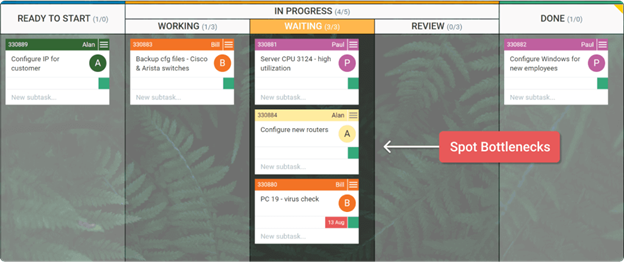
Unfortunately, bottlenecks are identified late: after blocking processes in a workflow.
Bottleneck analysis helps in pinpointing where the blockage in the workflow occurred and then addresses it. Bottleneck analysis is an ongoing process and a more structured way of looking at workflows in an operation.
You can apply the bottleneck analysis in an organization to save time (streamline processes faster), energy, and resources (hire more people or adopt new technology).
2. Value Stream Mapping (VSM)
Are your products providing the value that customers are looking for?
The answer lies within value stream mapping. This lean principle tool improves all the cycle steps required to convince customers that your products pack great value.
It gets ahead of the competition and creates a detailed visualization of the entire work process (from start to finish) while analyzing the value delivered to customers.
Value stream mapping displays all the people, processes, information, and inventory details in a flowchart to identify wasteful activities, view the work processes (or where waste stages form) and focus on future improvement.
To effectively perform a value stream map analysis, monitor lead time (and cycle time) of your tasks, throughput of your system, and amount of work in progress.
The cycle time and lead time should complement each other. Keep them together at all times. If you have a backlog or queue that delays customers from receiving their orders—but your processes are super-efficient—it won’t matter a great deal.
You can apply value stream methods in an organization by encouraging efficient communication, bolstering culture change, and improving processes.
3. Just-in-Time (JIT)
The JIT lean principle tool is perhaps the smartest production system in the world.
Toyota crafted the lean JIT model to make their entire production system work only with what it needs and to minimize wait times between each stage.
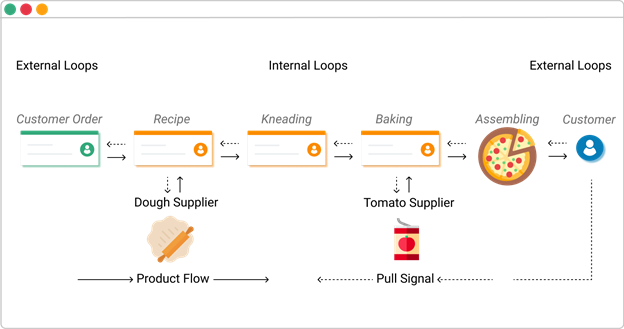
JIT is an inventory system that only makes what’s needed, when it’s needed, at every step of the production process. This tool forces you to minimize waste by creating only what’s required and not stocking up extra resources (to save time and money).
A case in point is the self-publishing sector. It applies this lean model to print only books that are ordered. Technological advancements (such as digital distribution of media products) have helped to minimize costs and waste of materials.
Same case with Dell. The technology solution giant adopted the JIT model and revolutionized the way computers are built by lowering inventory costs and utilizing resources more effectively to achieve sustainability.
You can apply the JIT lean model in your organization to improve quality and production flow and minimize the potential for disruption when implementing lean principles.
4. Error Proofing
Error proofing lean model (also known as “poka-yoke”—Japanese for “avoid mistakes”) identifies possible errors and then ensures they don’t progress to the next step of manufacturing. This lean model guarantees zero defects with near-zero inspection costs.
Shigeo Shingo, a Japanese industrial engineer at Toyota, is hailed for coining the term poka-yoke during the 1960s.
He’s also the brains behind zero quality control (ZQC)—a system that combines techniques from poka-yoke, which are meant to effectively correct possible defects and prevent defects through source inspection.
Error-proofing lean models help you avoid mistakes. For example, you’ll find a washing machine won’t start if the door isn’t closed properly to prevent flooding.
Another case in point is a car with an automatic transmission. Odds are, the car won’t start if the switch (requiring it to remain in “Park” or “Neutral” mode) isn’t turned on. Such automation processes, however small, prevent mistakes from happening.
5. Overall Equipment Effectiveness (OEE)
How do you pinpoint (and fix) the exact causes of waste in a process? By using the overall equipment effectiveness (OEE) lean principle tool.
This tool makes it possible to fix causes of waste in a process, boost productivity, and increase efficiency levels. It’s a yardstick for measuring whether the value you’re delivering to your customers is progressively scaling or stagnating.
When you measure OEE, you’re mainly looking for ways to systematically improve your processes—since OEE can reduce waste, identify losses, and monitor progress.
Running an OEE analysis helps you adopt principles of lean thinking. To discover what needs improving in your processes, measure OEE for a short time and at little cost.
Here’s how to measure OEE:

6. Root Cause Analysis (RCA)
How do you prevent problems before they occur or affect the work of your entire organization? You deploy the root cause analysis (RCA) tool. That’s how.
RCA lean tool identifies the root cause of a problem and provides a systematic approach for addressing it, especially in quality management systems.
This analysis is an important part of the principles of lean methodology as it defines, measures, analyzes, improves, and takes control of the underlying problem.
However, it’s important to run an RCA when experiencing specific problems, including persistent faults, critical failure, and a (negative) failure impact.
Here are steps to performing a root cause analysis:
- Define the problem: Find out the problem and how it affects customers’ needs.
- Collect relevant data about the problem: Document all the specifications and characteristics of the problem.
- Identify potential underlying factors: Discover factors contributing to the observed problem.
- Determine the root cause of the problem: Identify the causes of the problem.
- Prioritize the causes: Address all the causes and tackle them separately.
- Find a solution and implement: Find a solution to the problem.
Utilizing the root cause analysis template to analyze root causes of issues in a broader range of industries and sectors depends on its ability to solve problems and support a culture of continuous improvement. RCA can apply in the telecommunications, health and safety, and manufacturing sectors.
7. Plan-Do-Check-Act (PDCA)
The plan-do-check-act (PDCA) lean model is designed to implement change.
It plays an integral role in the principles of lean methodology and is a must-have for the continuous improvement of people and processes across organizations.
Walter Shewhart, the father of statistical quality control, is famous for proposing the PDCA concept, which William Deming (an eminent scholar) developed years later.
Thanks to these gentlemen, the PDCA is now a framework for constant improvement in the management and manufacturing sectors. The PDCA model ensures teams avoid making the same mistakes over and over again while improving processes.

Here are the four stages of the PDCA cycle (also known as the Deming Cycle):
- Plan: Identify the problem. Where and why did it start?
- Do: Involve everyone and execute the plan.
- Check: Analyze to see that everything went as planned.
- Act: Share the learning process.
This cycle is a powerful structure that helps fix issues on any level of an organization. PDCA lean tool also complements a bigger planning process such as Hoshin Kanri.
Chapter 8: Industries Benefiting From Lean Methodology
The principles of lean methodology offer customers value and get rid of waste cycle steps in a process while emphasizing doing more work (quickly).
Organizations globally (across a range of industries) have increased efficiency, improved quality, time effectiveness, and productivity thanks to adopting lean principles.
Here are some key industries that apply lean principles:
1. Healthcare
The healthcare industry gains much from adopting lean thinking methodologies.
Most medical professionals work with limited resources while maintaining great delivery of service (in this case, saving lives). In such an ecosystem, a health professional is forced to become more creative and highly skilled.
By applying principles of lean thinking, medical professionals can better reduce waste and excesses—compelling them to work on the most important areas or, better yet, prioritize specific medical practices.

Take ThedaCare, for example. The Wisconsin-based community health system increased the amount of time spent in direct patient care by nearly 70%. Their success (which also improved the work environment for nurses) is attributed to lean thinking principles.
Lean implementation at ThedaCare transformed a crisis-reactive system into a more proactive system that pursues strategies, processes, and methods— enhancing quality care for the patients and mitigating future crises.
Seeing ThedaCare boost its efficiency, the national health care system followed suit. It adopted waste reduction efforts—which translated to faster and more effective services, reduced wait times, and higher quality experiences for patients.
2. Construction
The construction and development industry has significantly improved over the years thanks to the implementation of lean management practices.
Construction is about building or improving properties in a short time while deploying a minimum amount of resources.
The principles of lean methodologies reduce waste material and improve productivity in a construction firm by eliminating waste, improving services, and saving money.
A good case in point is Skender. The design, construction, and manufacturing firm leveraged lean manufacturing practices to save time, money, and resources.
The company combined lean manufacturing principles with its modular construction approach—and other key technologies—to reduce cost and time to market its services.
Implementation of lean methods helped Skender develop a hyper-efficient process that successfully eliminated waste as well as cut the time it took to construct a building. This approach of construction heavily borrows ideas from Toyota’s lean concept.
3. Hospitality
So many hospitality organizations (such as hotels and resorts) struggle with efficiency. That’s because they do so many things at once—managing operations, reducing waste and excesses, and increasing productivity. It’s futile.
Prioritizing the right processes or modern methods and instruments to optimize productivity is the recipe for enhancing efficiency in the hospitality sector, and this involves adopting lean thinking practices.
You may have an effective coordination program, but more success is guaranteed when you apply a tight and lean approach on all fronts that seeks to significantly reduce costs in the future and structure internal processes more efficiently.
An example of lean management in the hospitality sector is Japan’s Yukai Resort. It operates with minimal staff and reduced costs and yet maintains quality service.
The resort attributes its success to applying lean management efforts where employee engagement is key. For instance, in their free time, receptionists at the resort will help in the kitchen or laundry area. They do this to offer great value to customers.
The Apex Hotels in the UK implemented lean methods that saved money and improved working conditions for the hotel staff. Lean thinking also helped eliminate non-value-adding activities in their laundry processes, saving nearly six man-hours every year for the whole hotel system.
Unlike other industries, the hospitality sector is more people-oriented.
People are an integral part of providing value to customers. So, principles of lean thinking in the hospitality sector are specifically designed to empower people.
4. Government
Government organizations are obligated to deliver more to communities with fewer resources. To improve services, state agencies are implementing principles of lean methodology to improve the education, transportation, and infrastructure sectors.
A case in point is the UK government. It proposed to use lean principles to eliminate inefficiency and encourage its supply chain to do the same—an idea projected to save approximately £250 million ($341 million).
At the time, the government’s commitment to adopting lean aimed to challenge current practices, improve performance, and refine processes to enhance efficiency.
Successful lean government organizations often implement gemba walks and morning huddles—both are lean thinking practices that access performance dashboards and form teams to actively seek ways to eliminate identified waste.
Chapter 9: Using SweetProcess to Implement Lean Principles
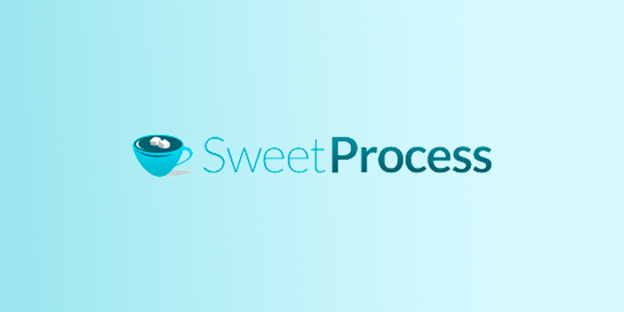
If processes in your organization are complicated, employees will waste time trying to figure them out instead of doing the actual work you need them to do.
SweetProcess is rooted in “lean thinking” methods that make complex and inefficient processes more efficient. It documents all repetitive tasks consuming your time (and resources) so you can focus on empowering your team to do their best work.
As organizations globally lose nearly 20 to 30 percent of revenue each year to inefficient processes, SweetProcess aims to boost productivity by compelling your team to spend less time firefighting a problem and more time creating value.
Here are real-life examples of how SweetProcess helped businesses effectively adopt principles of lean methodology:
A Building Company Uses SweetProcess to Embrace Lean Thinking
Turkstra Lumber, a family-owned and operated building company, desperately needed to streamline its processes and procedures. At the time, the business relied heavily on individual efforts laden with costly errors and inefficiencies to get things done.
To keep the organization’s operations running smoothly—and become more strategic and urbane—Jamie Ramsden (the company’s business intelligence and Lean Six Sigma champion) discovered SweetProcess and everything changed.
However, he was skeptical about using SweetProcess at first, citing a steep learning curve and a difficult-to-master system. But after some time, he got the hang of it. Soon, the organization’s efficiency surged and operations streamlined.
According to Jamie, adopting SweetProcess was a major turning point.
“The thing that caught my attention first was just something simple and visual, which is that SweetProcess makes you a little flowchart as you enter your steps for any process.”
SweetProcess helped the company adopt a lean thinking mentality by doing less documentation to focus on the bigger picture, avoiding costly mistakes by creating a centralized knowledge base, and saving resources to perform tasks efficiently.
“Try SweetProcess and […] start by documenting some processes that you think you know very well. Don’t do it yourself. Ask your people to do it and you’ll immediately find out that you don’t know what you think you did,” Jamie adds.
How a Canada-based Consulting Firm Implemented Lean Methods
Trailblaze Partners—a business management consulting firm that helps people-oriented consumer service industries better engage their people—needed to implement principles of lean methodology in a people-based company.
Speaking in a Process Breakdown Podcast episode, Rhys Green (founder and chief executive of Trailblaze Partners) intimates that, unlike machine-driven companies, implementing lean thinking methods to people-based industries is challenging.
He also reveals how he managed to implement lean thinking approaches in an Australian-based junk removal company by doing less and integrating [lean] culture.
In reality, he simplified (junk-sorting) processes at the company and created a lean culture by “[…] having a strong onboarding process and making sure that [managers] are going through interviews looking for a culture fit in terms of core values.”
Streamlining junk-sorting processes and improving work culture improved productivity, soaring yearly revenues of the junk removal business to hundreds of millions.
You too can systemize processes in your organization by using SweetProcess—a tool that documents processes, procedures, and (or) policies for your business, so that your team has all the information they need to be successful at their jobs.
Sign up today for a risk-free 14-day trial of SweetProcess with no credit card required. SweetProcess is available on iOS, Android, and web.
Conclusion: Want to Boost Organizational Productivity? Adopt Lean Principles
Today’s industrial ecosystem is highly modern and competitive. Unless you accurately adopt lean methodology principles, you won’t get ahead of the curve.
In reality, when you implement lean principles, you reduce costs and inefficiencies and cycle steps required to create a product.
Look at Toyota, for example. By adopting lean principles—then aptly naming its lean approach the Toyota Production System—the automobile giant minimized set-up times and waste, and automated systems to reduce human effort and chances of errors.
Same case with Intel. Lean methodology pushed the processor manufacturing giant to create high-performance, quality products. It also helped increase the efficiency of introducing a new chip to the factory from fourteen weeks to a mere ten days.
For the lean thinking approach to breed success, ensure (as a manager) to effectively communicate throughout the entire process.
However, if the adoption process proves difficult, several project management tools exist to ease the job.
A case in point is SweetProcess. The cloud-based standard operating procedure (SOP) software documents all repetitive tasks in one place, so you can grow your team and business with less time-consuming activities.
Sign up for a SweetProcess 14-day free trial today (no credit card required) and download the remarkable The Remarkable Lean Principles Checklist to effectively adopt the principles of lean and boost organizational productivity.
